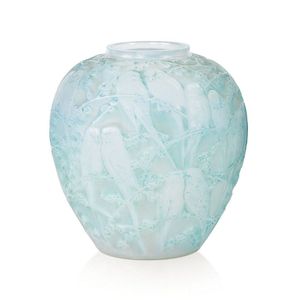Rene Lalique Formose Vase with Fish Pattern
You must be a subscriber, and be logged in to view price and dealer details.
Subscribe Now to view actual auction price for this item
When you subscribe, you have the option of setting the currency in which to display prices to $Au, $US, $NZ or Stg.
- Acid Etched - Acid etching is often used on glass, metals, and stone to create decorative finishes or to prepare the surface for further treatment or coating. The process of acid etching involves applying an acidic solution, such as hydrochloric acid or nitric acid, to the surface of the material and allowing it to react with the surface. The acid etches away a thin layer of the material, creating a rough, uneven finish. Acid etching can be used to create a variety of different finishes, from a subtle matte finish to a more pronounced, textured finish.
- Etched - Glass decorated with an etched design, which is achieved through marking out the pattern, protecting the area that is not be etched, and then immersing the object in acid to dissolve the surface of the unprotected area. With some glass objects, such as cameo glass, there may be several layers of different coloured glass, and part of the top layer is dissolved leaving the bottom layer as the background. The longer the time of exposure of the object to acid, the deeper the etching.
The word etching is also sometimes used to describe another method of decoration, where wheel grinders were used decorate the surface, but this technique is usually known as engraving. - Oviform /ovoid - The outline loosely resembling the shape of an egg.
- Patination / Patina - In broad terms, patination refers to the exterior surface appearance of the timber, the effect of fading caused by exposure to sunlight and air over the course of a century or more, changing the piece to a soft, mellow colour.
As patina is very difficult to replicate, it is one of the most important guides to determining the age of furniture.
Patina is also the term applied to the bloom or film found on old bronzes due to oxidisation.
This item has been included into following indexes:
Visually similar items

A good Rene Lalique Formose opalescent cased glass vase, spherical form, moulded in relief with goldfish, engraved signature and No. 934 to the base rim. Height 17.5 cm

A Rene Lalique Perruches vase, designed 1919, the baluster body moulded with a repeating pattern depicting pairs of parakeets perched on branches against a leafy background, in opalescent and frosted glass with a grey patina, moulded R. Lalique, 25.5 cm hi

A Chinese Blanche de Chin ceramic Pillow, 20th century, modelled in the form of a recumbent boy. 19 x 28 cm.

A Rene Lalique Herblay vase, designed 1932, the tapering cylindrical body moulded with a continuous pattern of fan motifs, in frosted and opalescent glass with a blue patina, acid etched R. Lalique France, 18 cm high. Provenance: G.D Renshaw, Grays Antique
